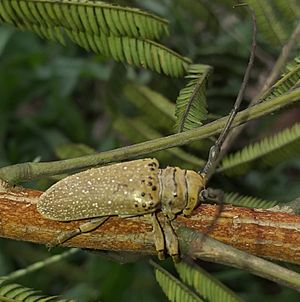Oncideres colombiana facts for kids
Quick facts for kids Oncideres colombiana |
|
|---|---|
 |
|
| Scientific classification | |
| Synonyms | |
|
Have you ever seen a beetle with really long antennae? Meet the Oncideres colombiana, a fascinating type of beetle! It belongs to a family called Cerambycidae, which are often known as longhorn beetles because of their impressive antennae.
Scientists named Dillon and Dillon first described this beetle in 1946. This means they were the first to officially study it and give it its scientific name.
This special beetle lives in a few different countries in South America and Central America. You can find Oncideres colombiana in places like Venezuela, Panama, and Colombia.
Contents
What is a Beetle?
Beetles are amazing insects that belong to a group called Coleoptera. This is the largest group of insects on Earth! There are hundreds of thousands of different kinds of beetles.
Beetles have a tough outer shell that protects their bodies. This shell is actually their front wings, which are hard and not used for flying. Their flying wings are tucked neatly underneath.
Most beetles have four main life stages: egg, larva, pupa, and adult. This is called a complete metamorphosis.
Where Does Oncideres colombiana Live?
The Oncideres colombiana beetle is found in tropical and subtropical regions. These areas have warm temperatures and often a lot of rainfall.
In Venezuela, Panama, and Colombia, these beetles live in forests and woodlands. They often spend their time on trees, which are very important for their survival.
What Does This Beetle Look Like?
Like other longhorn beetles, Oncideres colombiana likely has long antennae. These antennae can be even longer than their bodies! They use their antennae to feel their way around and to find food or mates.
The exact colors and patterns of Oncideres colombiana can vary. Many beetles in the Oncideres group have colors that help them blend in with tree bark. This helps them hide from predators.
The Life Cycle of Longhorn Beetles
The life cycle of Oncideres colombiana is similar to other longhorn beetles. It starts when an adult female beetle lays her eggs. She often lays them on or inside trees.
Once the eggs hatch, tiny larvae emerge. These larvae are often called "grubs." They are usually worm-like and spend their time boring into wood. They eat the wood as they grow.
After growing for some time, the larva changes into a pupa. This is a resting stage where the beetle transforms. Inside the pupa, the larva slowly changes into an adult beetle.
Finally, the adult beetle emerges from the wood. Its main job is to find a mate and start the cycle all over again.
Why Are Beetles Important?
Beetles, including Oncideres colombiana, play important roles in their ecosystems. Some beetles help break down dead wood, which recycles nutrients back into the soil.
Other beetles might help pollinate plants or control insect populations. Every creature, big or small, has a part to play in nature!
See also
 In Spanish: Oncideres colombiana para niños
In Spanish: Oncideres colombiana para niños

